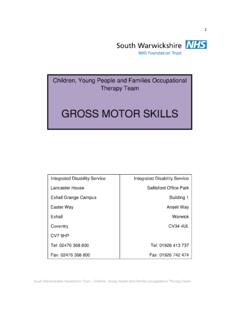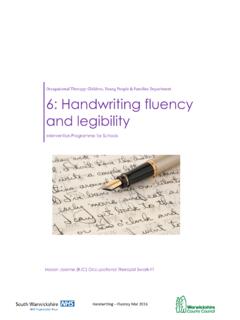Transcription of Dressing Skills - swft.nhs.uk
1 1 South Warwickshire Foundation Trust Children, Young People and Families Occupational Therapy Team Integrated Disability Service Lancaster House Exhall Grange Campus Easter Way Exhall Coventry CV7 9HP Tel: 02476 368 800 Fax: 02476 368 800 Integrated Disability Service Saltisford Office Park Building 1 Ansell Way Warwick CV34 4UL Tel: 01926 413 737 Fax: 01926 742 474 Children, Young People and Families Occupational Therapy Team Dressing Skills 2 South Warwickshire Foundation Trust Children, Young People and Families Occupational Therapy Team Contents Page Number Contents 2 Pre- Dressing Skills 3 - 4 Activities to promote Pre- Dressing Skills 4 General Dressing Principles 6 - 8 Examples of breaking individual tasks down 6 Positioning 7 Ensuring Clothes are the Correct Way Round 8 Gripping Clothes 8 Different Ways to Learn Dressing Skills 9 Backward Chaining 9 Forward Chaining 9 Alternate Method 9 Levels of Assistance 10 - 11 Socks 12 Shoes & Shoelaces 13 Shoelace Teaching Technique The Standard One-Loop Method 14 Shoelace Teaching Technique The Two Loop Method 15
2 Alternative Shoelaces 16 - 17 Fastenings 18 - 19 Buttons 18 Zips 19 Common Dressing Tasks Broken down into Steps 20 Putting on a T-Shirt 21 How to tie your school Tie 22 3 South Warwickshire Foundation Trust Children, Young People and Families Occupational Therapy Team Pre- Dressing Skills Dressing is a complex activity that requires many pre-requisite Skills to be able to perform successfully. Below is a quick reference guide to pre-requisite Skills to gain an understanding of the demands the activity places on the child. Motor Skills a child needs to be able to move limbs and body in a full range of movements both with and against gravity.
3 For this, the child must have adequate muscle strength and flexibility at their joints. Co-ordination a child needs to be able to create co-ordinated movements, using both unilateral (using one arm) and bilateral Skills (using both arms). Hand dominance is important for movements that require fine motor Skills , such as fastening buttons. A child needs to be able to cross their midline to complete tasks such as removing a jumper. Balance a child must be able to maintain their balance whilst changing posture/position with and without vision occluded. Fine Motor Skills a child must be able to reach, grasp and release objects in order to complete tasks such as buttoning or holding the item of clothing.
4 Perception a child needs various perception Skills , such as form constancy ( knowing various sizes and shapes of buttons are all still buttons) and spatial awareness ( knowing the position of body in space related the position and size of arm holes). Stereognosis the child must be able to feel objects to know their relation to their body without relying on sight, for example, finding arm holes with jumper over head or doing back buttons. Body Schema A child must have good awareness of body parts and where their body is in space. A child must be able to differentiate their left and right to know which arm hole is correct.
5 4 South Warwickshire Foundation Trust Children, Young People and Families Occupational Therapy Team Activities to promote Pre- Dressing Skills Dressing should not be seen as a chore. Try to keep it fun. Play Dressing up games and Dressing toys. Dressing dolls: using age appropriate dolls to dress up provides the child with increased sense of body schema and organisation of clothes. It also provides a way of completing Dressing Skills whilst being able to use vision Skills . Musical Dressing up (a variation of musical chairs): the children put items of clothing on from a pile until the music stops, at the end of the game the child with the most clothes on is the winner.
6 Using a variety of large shirts or smocks, get the children to get ready for wet play, painting or cooking. Button boards or play cubes. These can be made to give the child practice at certain types of fastening. Cloth button or popper book. Parts of a picture have to be buttoned or 'popped' on. Matching sock game. Place a variety of socks in a pile, the child has to find pairs and put them on. Wooden shoe - a shoe-shaped piece of card or wood with holes in can be used to practise lacing and tying shoes. Bow book. A fabric book with different types of materials to make a bow, ribbon, laces, apron strings, etc.
7 Package wrapping. Making parcels and tying them up with different sorts of ties. Play Simon Says and get the child to identify various body parts. Start with arm, leg, tummy. Move onto ankle, elbow, knees. Build upon this by asking the child to touch left arm, then right leg. Finally being able to locate left elbow, wrist, etc. Completing threading activities. Getting them to copy a pattern of various sized beads on thread (wool is better for larger beads) to improve pattern recognition. Adapt the task by getting the child to pull desired bead from bag without looking to improve stereognosis. 5 South Warwickshire Foundation Trust Children, Young People and Families Occupational Therapy Team Complete lacing activities using lacing boards to develop fine motor Skills such as grip, release and eye-hand co-ordination.
8 Labelling clothes. Let the child develop labels for their clothes, front, back, etc. Ensure that you are able to remove them. OR get an old white t-shirt and paint on labels. This will help raise body awareness and will assist with orientation. Posting coins. Let the child use pincer (finger and thumb) grip to post coins into a money box. Once child has mastered this, post pennies through slit in piece of paper. This will help develop pre-button Skills . The Hokey Cokey . Get child to participate in this song, could be part of group to enhance body awareness. Completing jigsaws and form boards will assist with visual perceptual Skills .
9 Foot massage. Give the child a foot massage to provide sensory input to increase awareness of feet. This can also be achieved by walking on various surfaces barefooted, grass, concrete, etc. Do these as a preparation for putting on shoes and socks, tying shoelaces. Clothes Pictures. Make a picture representation of the clothes the child is wearing and get him/her to talk through what order they are going to undress/dress in, this will improve motor planning and organisation. These pictures can then be used as a reference point for future Dressing sessions. 6 South Warwickshire Foundation Trust Children, Young People and Families Occupational Therapy Team General Dressing Principles Try and do each Dressing task the same so a routine can be established.
10 In order for the child to be able to learn new Skills the environment must be appropriate. Think about the noise levels and distractions; other children in the room, computers, pictures on walls, toys and smells, from the kitchen. Allow extra time for the child to be able to learn the new techniques. Progress at the child s pace and give lots of praise for practicing Skills even if they are not successful at completing the task. Success is important; therefore begin with breaking the Dressing activity into small, straightforward steps. Tackle one step at a time and give help where needed with the other steps of the task, help the child to pull the t-shirt over their head and then allow them to put their arms through the sleeves.




